Two-Handed Jazz Voicings: A Practice Guide
Find the full article on (Patreon)
One of the most common difficulties among jazz piano students is playing two-handed voicings. Generally, the problem is twofold: What are the “good” voicings and how do you practice them?
There are lots of resources on jazz voicings. With a little bit a research, it’s not difficult to discover a huge range of rich, interesting voicings that jazz pianists may use when improvising. Spatially speaking, these resources often contain redundancies, which means practicing is less efficient. They also aren’t integrated with practice structures. In my experience, teaching voicings (or any musical concept), should include methods of practice, or else students will practice aimlessly, resulting in bad habits and wasted time.
In this article, I’ll be thoroughly exploring ways to integrate voicings, practice, and physical relationships at the piano. I’ve divided the article into these sections:
–
- Problem Solving – Integrating Voicings with Physical Relationships (950 words)
- A Place to Start #1: Pentatonic Voicings (440 words)
- How to Practice Pentatonic Voicings (1500 words)
- Combining Pentatonic Scales and Voicings (850 words)
- A Place to Start #2: Quartals (350 words)
- How to Practice Quartal Voicings (200 words)
- Combining Quartal Voicings and Harmonies (380 words)
- Advanced Quartal Exercises and Sequences (670 words)
- Combining Quartal and Pentatonic Voicings (970 words)
- Exploring Two-Handed Voicings with Physical Play (1500 words)
–
Problem Solving – Integrating Voicings with Physical Relationships:
In order to design the most appropriate and efficient practice structures, it’s important to identify some typical problems when playing chords, and reflect on some of the physical relationships involved. Generally, there are three problem areas, which have various degrees of overlap:
- Dependence on functional divisions between the hands
- Dependence on root for spatial framing
- Lack of spatial variety within voicings
Functional Divisions
The simplest framework for understanding functional relationships is on a spectrum of foreground/background, melody/accompaniment etc. At the piano, I often think about fulfilling three functions: bass, melody, and accompaniment (chords). Students typically have a difficult time juggling functional relationships while improvising. Here are some examples of functional divisions between the hands:
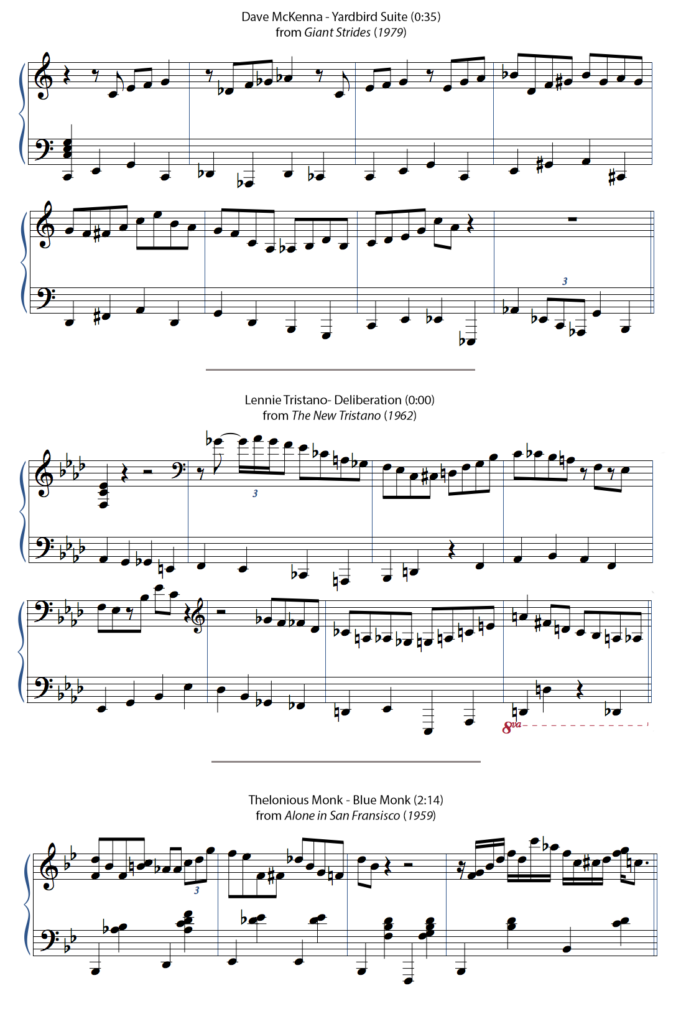
In these examples, the hands are functionally independently from the other. The left hand is restricted to only playing bass and/or only playing chords. Likewise, the right hand is restricted to only playing chords, or playing melodies. Nowhere are the hands working together as one functional unit. There’s nothing inherently wrong with this except that it physically limits the pianist to certain sounds. When chords are restricted to one hand, they need to be in a closed, keyboard style – It’s impossible to play open, dense, and harmonically rich voicings. It’s also often the case that students are dependent on these functional divisions and struggle to break out and play differently.
This next example is from a transcription of Fred Hersch’s Waltz. Though his hands are ALSO covering melodic and bass functions, you can clearly see (and hear) how both hands contribute to the chords and voicings.
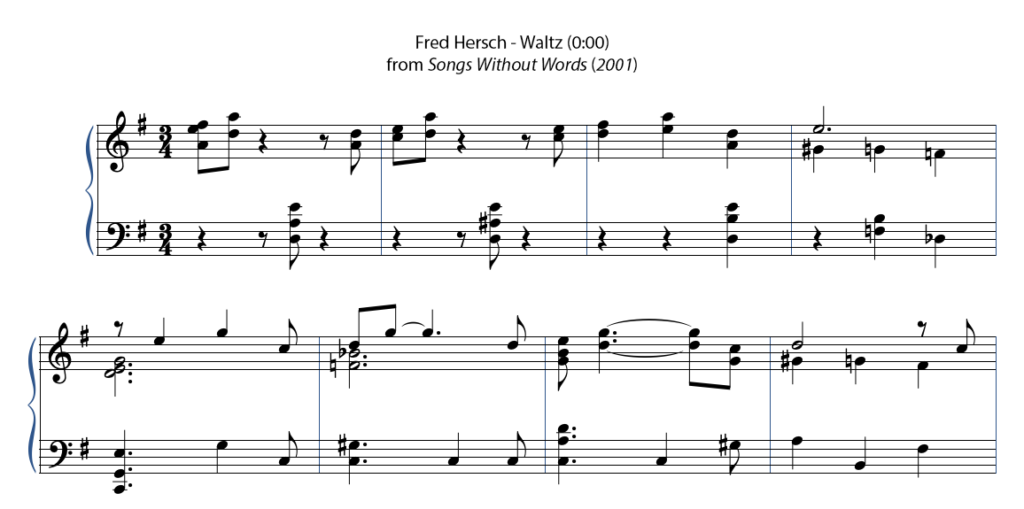
One goal in practicing two-handed voicings is to encourage the hands to work together as one functional unit. This includes feeling and visualizing all the spatial relationships with the hands separately, with the hands together, and as they move up and down the keyboard.
Spatial Framing
Theoretically speaking, the note “C” can fulfill many different harmonic functions – as the root of a chord, the 3rd, the sharp 11th, a melody, an inner voice etc. I call the changing of harmonic relationships around a common note “framing.”

When harmony intersects with playing the piano, we use spatial framing to perceive and play the notes on the piano that make up a key, a harmony, or a voicing. For example, playing “C” as the root of a C Major triad encourages us to visualize, become aware of, and spatially frame this harmony from left-to-right and bottom-to-top along the keyboard.

Bottom-to-top and left-to-right are the most natural way to visualize and play harmony/space at the piano. Chords and their roots are central to a pianist’s understanding of music theory and are some of the most common units of communication between musicians. So, this bottom-to-top and left-to-right perception is constantly being encouraged and reinforced when we communicate about harmony at the piano.
The problem is that when improvising over chord progressions, spatial framing only from the root is time consuming and inefficient. When chords are changing, framing from the root causes a “spatial reset” as chords are re-built from the left-to-right.
Of course, I don’t really know how mental and spatial processes unfold at the piano. Though, with observation, I’ve come to believe that framing notes quickly at the piano relies on more than just a relationship with the root. Experienced pianists use spatial framing not just from left-to-right, but ALSO from right-to-left. It’s also likely that over time with practice, spatial framing is a more integrated, holistic process and includes out-to-in, and in-to-out.


This means a general goal when practicing should be to cultivate spatial awareness and spatial framing from right-to-left and top-to-bottom. Because voicings can also include bass and melodic functions (like the Fred Hersch example above), we’re going to start with focusing exclusively on the chords themselves, without always playing roots.
Spatial Variety
When teaching jazz theory, we often stack thirds from every note of the major scale to form chords.

The 9th, 11th, and, 13th degrees are often called “upper extensions” and “colour tones” because they don’t contribute to the overall function of the chord. So, we’re left with these common 4-note chords as the foundation for understanding jazz harmony:

At the piano, 4-note chords are convenient chordal structures because they can easily be played in one hand. It’s also common practice to play them in inversions to get faster at recognizing their unique spatial relationships.

The skill ceiling for understanding and playing 4-note chord progressions is relatively low. With consistent practice, a student’s skill curve would be mostly linear. Skill curves plateau considerably with two-handed voicings and playing upper extensions. With a much higher skill ceiling, students take shortcuts to playing two-handed voicings which result in a lack of spatial variety within their voicings and overall bad habits.
For example, if a pianist is aware of the notes and space that makes up a Cm7, it’s relatively easy to articulate that space in different octaves with both hands.
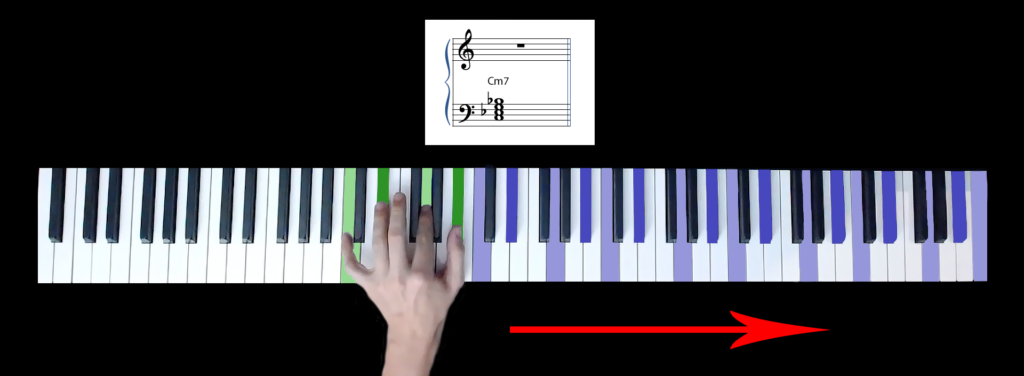
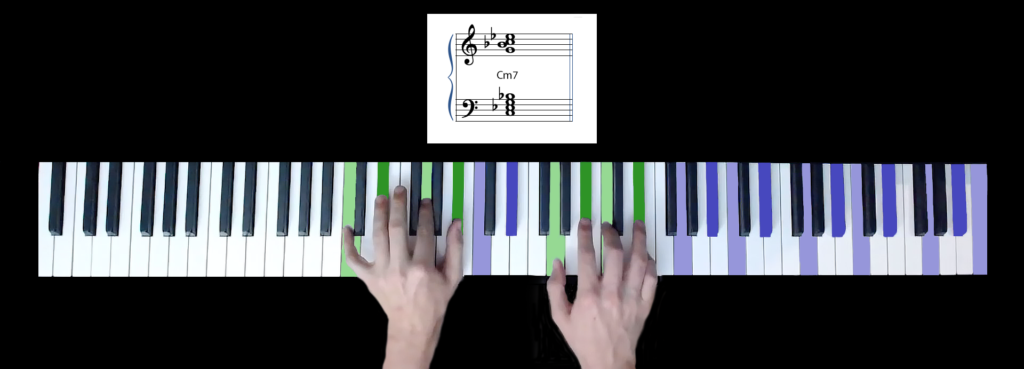
This achieves a much wider, denser sound, but lacks richness – notes are being doubled, chords are limited to four notes, and the voicings are still being played in closed, keyboard-style positions, albeit with two hands. This example might be an exaggeration of bad voicing habits, but most of the bad habits I see in students are from the same issue: a lack of spatial variety in chord practice.
The most elegant way to solve this is to practice voicings built on 4ths, instead of 3rds. As we’ll see in the rest of the article, 4ths are inherently more open, richer, can be neatly organized into manageable practice structures, and cover a huge chunk of contemporary jazz voicings.
A Place to Start #1: Pentatonic Voicings
Let’s start with stacking perfect 4ths. Eventually, we get the pentatonic scale:

(Depending on your perspective, you may call this the F minor pentatonic scale, or the Ab major pentatonic scale. I prefer to use F minor pentatonic)
From every degree of the pentatonic scale, we can stack every other note to form two-handed, open voicings.

Lastly, to help establish spatial reference points between the hands, I’ll double the top note on the bottom.
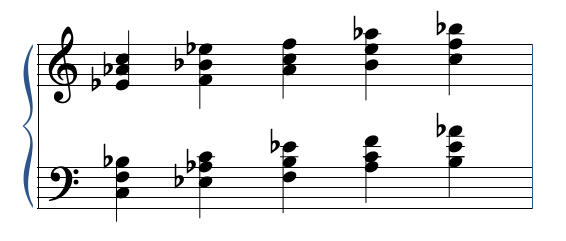
I like using pentatonic voicings as a place to start practicing because they’re very simple, yet expressive and versatile. If you’re not familiar with these shapes and spatial relationships at the piano, these voicings represent your first practice goals: Play the following ascending and descending at tempo ‘x.’

Throughout the process of learning how to achieve this goal, you will become familiar with some of the spatial relationships in the hands individually and collectively that make these voicings unique. I’ll break them down.
Individually, the most common spatial relationships are two stacked 4ths, which form a minor 7th from the bottom note.

The most challenging part of learning these voicings is become aware of where the major 3rd fits under the fingers.

The hands individually will be playing these notes either as an Ab major triad in 2nd inversion, or an F minor tried in 1st inversion.
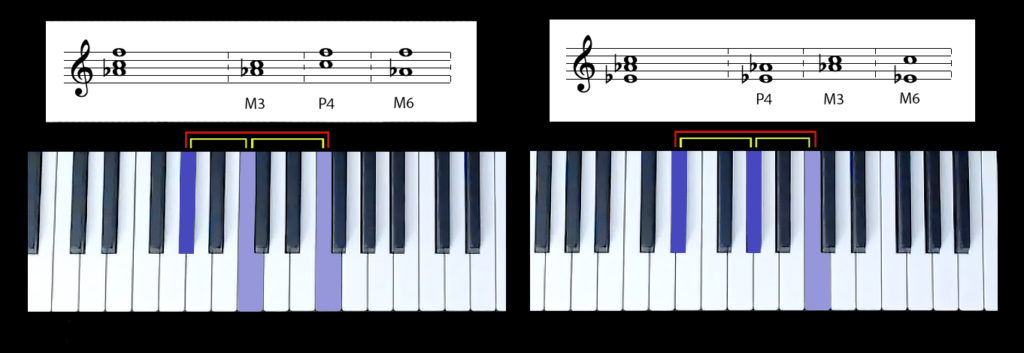
When playing hands together, practice includes connecting spatial references points between the hands. Spatial reference points are like shortcuts that help us know how to move our hands in relationship to each other. For example, I’m aware of at least two spatial references that I use to play these voicings in both hands – the space between my 5th fingers (out-to-in) and the space between my thumbs (in-to-out):
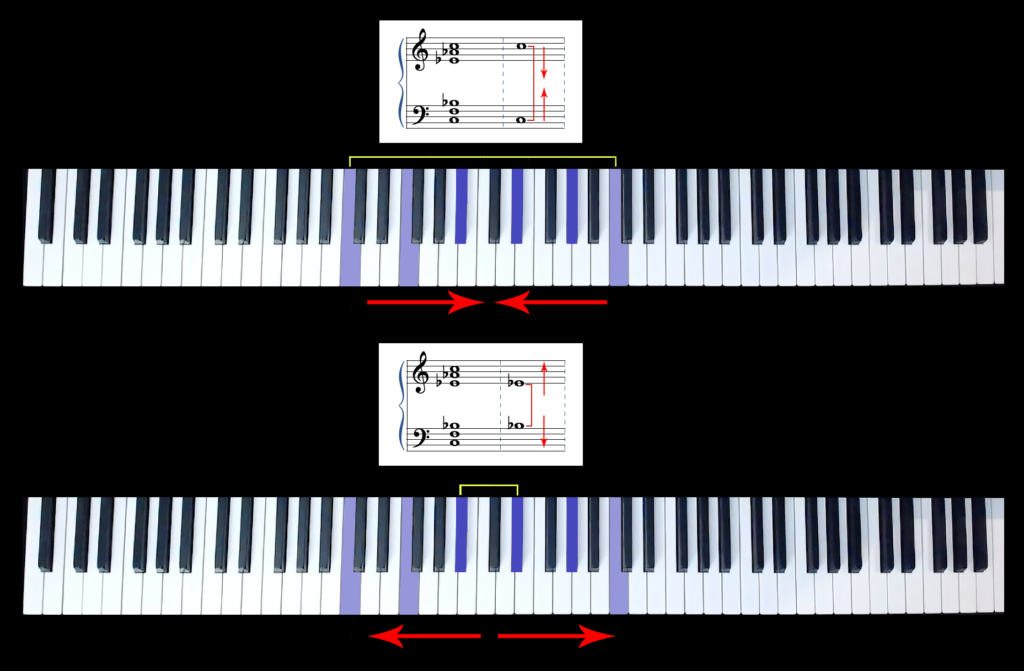
These kinds of visual and spatial references may depend on the pianist. Some pianists may find it easier to use the space between the index fingers as reference. Whether done consciously or not, pianists use spatial references to connect the hands and move them up and down the keyboard as a single functional unit.

These observations may be unnecessarily dense. But my goals here are twofold. First to integrate the ideas of voicings and chords with actual spatial relationships, directional relationships and physical gestures at the piano. The second is to give students permission to use all means necessary to learning these gestures. Playing the piano is a physical and visual activity just as much as it’s an aural, intellectual and theoretical one. With a heavier focus on the theoretical aspects, we can lose sight of the possibilities that our strengths in learning are in the visual and physical realms.

Comments
Geoff
October 30, 2022 at 10:49 pmVery useful; many thanks